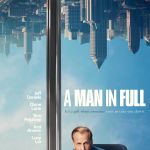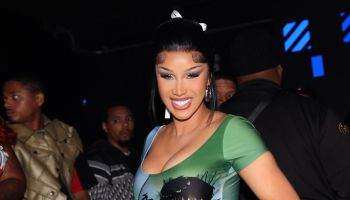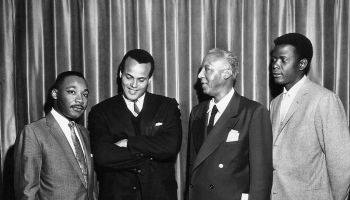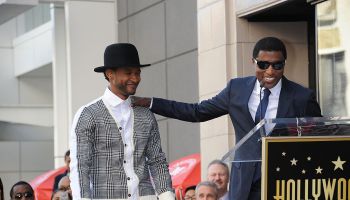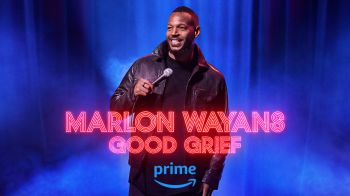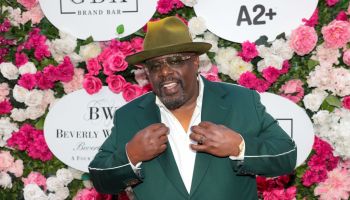Every year, The Fader magazine ― known for celebrating what’s au courant and innovative ―
pays tribute to artists whose contributions to music, style, film and culture have laid a solid foundation for greatness. This year, it was almost kismet. The magazine’s icon issue will be it’s 73rd; the Notorious B.I.G. was born in ’73; and Fader founder/CEO Rob Stone had the good fortune to have met and hung out with the hip-hop legend before his untimely death, so it was only right to honor Biggie.
And, let’s not forget the definition of the word. Icon: an object of uncritical devotion. Hip-hop has been ― and forever will be ― devoted to B.I.G. The Fader Icon Issue with the late, great Christopher Wallace is available on newstands across the country today (May 3).
Global Grind: What went into the decision to have Biggie on this upcoming icon issue?
Rob Stone: Before I started The Fader I was working for Arista records. They brought me in to be the liaison for Bad Boy Records. At the time Puffy ― he’s now Diddy, but he was Puffy back then ― was starting his label and they brought me in, so I spent two years of my life working with Biggie, Craig Mack, Faith and Total and Puffy at the time … And when we started the magazine in ’98, it was always in the back of my mind to put this issue together. As time went by, everyone was always caught up in the controversy and murders and what happened. It was always about bringing up old beef, but, to me, I always thought it was important to celebrate Biggie’s life. It seemed like every time we were getting ready to do it there was more on the controversy and that was the last thing we wanted to focus on, so it just seemed like now is a good time.
There’s a lot of things that ended up working out … the fact that Big was born in 1973 and this was our 73rd issue. Our icon issue comes out in May and his birthday is May 21st, so there were just a lot of things that lined up like that. We just always wanted to celebrate, respect and tribute Big and everyone that was involved in his career and really focus on him as a person and not just an icon.
[pagebreak]
When did you come up with concept to have a Fader icon in the first place?
I’d have to check, but it was early on in the life of the Fader. As long as we cover things through a Fader lense we’d be ok. We never looked at it like genre specific music. We try to just cover the best in music. Whether it was the White Stripes first cover, or Neptunes first cover or Kanye or Drake, we never say ‘well, we’re this magazine’ or ‘that magazine.’ Let’s just cover great music. We felt that it would just be really interesting to do that with iconic artists since we do that with emerging artists. It’s been cool to be able to dedicate one issue a year to an icon. In the past we’ve done Miles Davis, Nina Simone, David Byrne and we just thought it was time for the Biggie issue.
What would you say to someone who doesn’t get it, who doesn’t understand why you’re celebrating B.I.G.?
I would say go back and listen to the music, go back and listen to the story telling. I think he saw things on a much different level than most of us. There is a lot of depth to him. If you listen to the words and the lyrics and the stories … he was able to tell [them] in a very compelling way, in a flawless way. Even looking at the issue, the main feature story was written by this guy Andrew Noz, he talked about it. He said most rappers have a period of their career that they really don’t want to touch upon. Either they’re a back-up dancer or were in some corny group before they put on their hard hip-hop self image. You didn’t have that with Big. What you saw was what you got. He didn’t do anything corny before he became the Notorious B.I.G. That’s who he was. And as much as he talked about hip-hop doesn’t mean that much to him, it’s just a way to make money. You could see how meticulous he was in every word, every syllable, in what he did. It was well thought out. And that was his life.
[pagebreak]
What’s your fondest Biggie memory?
That’s what great about this issue, there are a lot of great stories. That was one thing we set out to do in this issue was tell stories that have never been told before. Then there were things I found out that I never knew. Dan Smalls, in the issue, tells the story of the first time Big and Tupac hung out in L.A. Greg Nice was with them and Groovy Lou and they cancelled everything on Big’s schedule when they ran into him. I won’t give the whole story away, but they went back to Pac’s house and they just turned into kids having a great time.
In the issue, I described the first time I heard the “Ready to Die” album. Puff called me down to the office and I was probably one of a handful of people who got to hear it. I just remember sitting there in awe going, ‘oh my god, this is going to be one of the greatest albums of all time.’ You sensed something was going on with Bad Boy and with Puffy and even the waiting area had all these artists trying to get signed and demo tapes and street teams with all their flyers and posters. It was like a movement that you knew was happening.
Does it feel like those days are over in a bad or unfortunate way?
I was doing an interview on Sirius the other morning and one of the callers asked, ‘what do I think it would have been like if Big was still in the game? Would Jay be as big as he is?’ I think they would be as big if not bigger. Big would have been making records. Think of the records that would be being made right now … Think of the movies … The clothing line that he talked about … Think of the impact that he would have had on the community, on young people, not just in our country. We’re doing a post on Facebook right now to design your Fader cover and we’re getting posts from Africa, and Europe and places all over the world and this guy has touched their lives. He did by the time he was 25. If you look at people who have gone on to do great things, they’ve done it in their late twenties, thirties, fifties. He did it at such a young age. I think it’s changed, but I definitely think he would raise the bar for what’s going on, but you know, guys like Kanye, Lil’ Wayne, Jay, they’re making incredible records … Records that I think he would be proud of. It makes you think, “I never thought hip-hop would make it this far.” It just keeps going. It probably would have gone further and faster with him in the game.
New York Times referred to Fader magazine as the music and style Bible. What’s the strategy to keep that going?
For us it’s always about young energy. About really reaching into communities and going and travelling and experiencing. I think a lot of magazines today get caught up in doing their research in the Internet and through phone calls. We spend so much of our time getting out there and visiting cities, whether it’s here in the states or if it’s abroad. We don’t have a mission like we need to find something new, it’s more, who’s doing something interesting right now. What cities are popping, what’s happening out there that hasn’t been covered? Whether it’s a new M.I.A. or cool fashion that’s happening elsewhere in the world.



